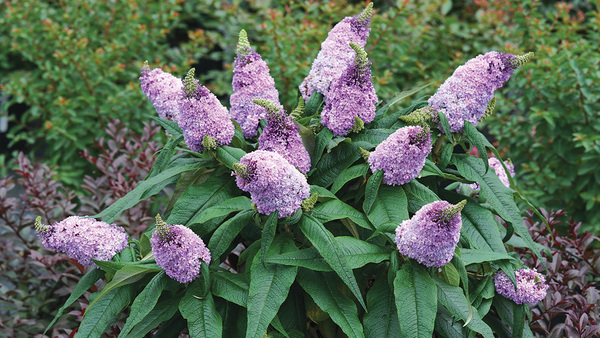
In Paul Westervelt’s article on perennial upgrades, he explains the benefit of stepping out of your comfort zone and trying new versions of tried-and-true plants:
“After whiffing a few times, consumers and pros alike may be tempted simply to stick to time-tested varieties. But some of those varieties aren’t what they once were. In other cases, they’ve been upgraded in meaningful ways that improve the gardening experience—better habit, longer bloom time, enhanced disease resistance. Before you swear off new plants forever, consider these classic upgrades.”
To help you find plants that won’t make you say, “Ugh, I should have just stuck with the original,” we asked regional experts to pick four improved versions of fan-favorite plants. All of these plants have at least one of the characteristics that Paul lists above—better habit, longer bloom time, enhanced disease resistance—and sometimes all three. Find improved plants for California below, and for even more improved classics, check out Paul’s article 8 Better Perennial Plants to Grow Over the Classic Varieties.
1. ‘Blue Heron’ corydalis

Name: Corydalis curviflora var. rosthornii ‘Blue Heron’
Zones: 6–8b
Size: 8 to 10 inches tall and 9 to 12 inches wide
Conditions: Full sun (coast) to partial shade (inland); evenly moist, well-drained soil
Native range: China
How can anyone resist the alluring ‘Blue Heron’ corydalis? Its smoky foliage couples with gentian blue flowers on red stems to evoke a sultry feeling. Discovered by Dan Hinkley in Sichuan, China, ‘Blue Heron’ blooms from late spring through autumn. It grows well as a ground cover under trees in a woodland design, combining nicely with foam flowers (Tiarella spp. and cvs., Zones 4–9) and navelwort (Omphalodes spp. and cvs., Zones 5–9). Heavy mulching with shredded redwood bark easily deters slugs and snails. Providing summer water will keep it robust and blooming through fall.
2. ‘Prairie Fire’ vine maple

Name: Acer circinatum ‘Prairie Fire’
Zones: 5–9
Size: 6 to 10 feet tall and 10 to 15 feet wide
Conditions: Full sun (coast) to partial shade (inland); average soil
Native range: North American west coast
Create fireworks in your garden with the petite ‘Prairie Fire’ vine maple. But don’t let its diminutive size fool you; this cultivar of the native vine maple, which is found growing throughout the redwood forests of coastal Northern California, bursts with exciting color. Light green, lacy-textured leaves cluster on branches that are orange-red. Not vinelike at all, the tree has an open vase shape. When autumn arrives, the leaves turn yellow before dropping. Colorful twigs and branches offer winter interest afterward. Summer watering is a must for this tree to look its best and remain healthy. It tolerates a wide range of soil types.
3. ‘Purple Haze’ catmint

Name: Nepeta ‘Purple Haze’
Zones: 6–10
Size: 4 to 10 inches tall and 30 inches wide
Conditions: Full sun; well-drained soil
Native range: Hybrid
This bold catmint deserves prime positioning in a pollinator garden. Bees and butterflies alike love the loose clusters of purple flowers that stand well above the swollen mound of foliage. The soft 2-inch-long leaves are heavily textured with gorgeous veining throughout. A thin silvery sheen to the foliage makes ‘Purple Haze’ glow softly. Unlike other catmints, this one holds its shape well all summer long and does not collapse in the center as the season progresses. Summer watering and a light shearing of spent flowers is all that is required to keep ‘Purple Haze’ true to form through autumn.
4. ‘Cavatine’ Japanese andromeda

Name: Pieris japonica ‘Cavatine’
Zones: 5–8b
Size: 2 feet tall and 3 feet wide
Conditions: Full sun (coast) to partial shade (inland); evenly moist, well-drained soil
Native range: Eastern China, Taiwan, Japan
This tidy, well-behaved andromeda quietly rests until spring. Then suddenly cascades of pure white flowers tumble forth and it becomes all abuzz with bumblebees. ‘Cavatine’ Japanese andromeda’s pleasantly plump habit of leathery green leaves creates a soothing feeling in an inland shaded garden. A thick planting serves well as a low shrub border. ‘Cavatine’ really shines when combined with a Japanese maple (Acer palmatum and cvs., Zones 5–8) or katsura tree (Cercidiphyllum japonicum, Zones 4–8). For the best performance, use an acidic fertilizer, and add an iron-based fertilizer if the leaves turn pale. Also, keep it well watered during the summer months. Occasional, minimal pruning will keep it in shape.
Horticulturist Terry Kramer is site manager for Humboldt Botanical Garden in Eureka, California.


















Comments
Log in or create an account to post a comment.
Sign up Log in